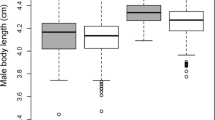Summary
Variance in lifetime mating success was measured for individuals of a population of Enallagma hageni, a non-territorial damselfly in northern Michigan. E. hageni is an explosive breeder with scramble competition for mates. Highly skewed operational sex ratios resulted in intense male-male competition which took the form of interference with tandem pairs. 41% of the males failed to mate in their lifetime as opposed to only 3.6% mating failure in females. The effect on mating success of size, age, longevity, and time spent at the breeding site were investigated. Intermediate sized males obtained the most matings, and male lifetime mating success was highly correlated with longevity.
Similar content being viewed by others
References
Alcock J (1981) Lek territoriality in the tarantula hawk wasp Hemipepsis ustulata (Hymenoptera: Pompilidae). Behav Ecol Sociobiol 8:309–317
Alexander RD, Hoogland JL, Howard RD, Noonan KM, Sherman PW (1978) Sexual selection and breeding systems in pinnipeds, ungulates, primates, humans. In: Chaquon NA, Irons WG (eds) Evolutionary biology and human social behavior. Duxbury Press, North Scituate, Massachusetts
Bateman AJ (1948) Intra-sexual selection in Drosophila. Heredity 2:349–368
Berven KA (1981) Mate choice in the wood frog, Rana sylvatica. Evolution 35:707–722
Bick GH, Bick JH (1963) Behavior and population structure of the damselfly Enallagma civila (Hagen) (Odonata: Coenagrionidae). Southwest Nat 8:57–84
Borgia G (1981) Mate selection in the fly Scatophaga stercoraria: female choice in a male-controlled system. Anim Beh 29:71–80
Campanella PJ, Wolf LL (1974) Temporal leks as a mating system in a temperate zone dragonfly (Odonata: Anisoptera) I. Plathemis lydia (Drury). Behaviour 51:49–87
Corbet PS (1962) A biology of dragonflies. Witherby Press, London
Crow JF, Kimura M (1970) An introduction to population genetics theory. Burgess Press, Minneapolis
Emlen ST (1976) Lek organization and mating strategies in the bullfrog. Behav Ecol Sociobiol 1:283–313
Emlen ST, Oring LW (1977) Ecology, sexual selection, and the evolution of mating systems. Science 197:215–223
Garrison RW (1978) A mark recapture study of imaginal Enallagma cyathigerum (Charpentier) and Argia vivida (Hagen) (Zygoptera: Coenagrionidae). Odonatologia 7:223–236
Gibson RM, Guinness FE (1980) Differential reproduction among red deer (Cervus elaphus) stags on Rhum. J Anim Ecol 49:199–208
Howard RD (1978) The evolution of mating strategies in bullfrogs, Rana catesbeiana. Evolution 32:850–871
Jacobs ME (1955) Studies on territorialism and sexual selection in dragonflies. Ecology 36:566–586
Johnson C (1964) Mating expectancies and sex ratio in the damselfly Enallagma praevarum (Odonata: Coenagrionidae). Southwest Nat 9:297–304
Johnson LK (1982) Sexual selection in a brentid weevil. Evolution 36 (in press)
Jolly GM (1965) Explicit estimates from capture-recapture data with both death and immigration-stochastic model. Biometrika 53:225–247
Kvelland I (1965) Some observations on the mating activity and fertility of Drosophila melanogaster males. Hereditas 53:281–306
LeBoeuf BJ (1974) Male-male competition and reproductive success in elephant seals. Am Zool 14:163–176
Lefevre G Jr, Jonsson UB (1962) Sperm transfer, storage, displacement and utilization in Drosophila melanogaster. Genetics 47:1719–1736
Mason LG (1964) Stabilizing selection for mating fitness in natural populations of Tetraopes. Evolution 18:492–497
McLain DK (1981) Interspecific interference competition and mate choice in the soldier beetle, Chauliognathus pennsylvanicus. Behav Ecol Sociobiol 9:65–66
Miller PL, Miller CA (1981) Field observations on copulatory behavior in zygoptera with an examination of the structure and activity of the male genitalia. Odonatologica 10:201–218
Parr MJ, Palmer M (1971) The sex ratios, mating frequencies and mating expectancies of three coenagriids (Odonata: Zygoptera) in northern England. Entomol Scand 2:191–204
Payne RB, Payne K (1977) Social organization and mating success in local song populations of village indigobirds, Vidua chalybeata. Z Tierpsychol 45:113–173
Scheiring JF (1977) Stabilizing selection for size as related to mating fitness in Tetraopes. Evolution 31:447–449
Severinghaus LL, Kurtak BH, Eickwort GC (1981) The reproductive behavior of Anthidium manicatum (Hymenoptera: Megachilidae) and the significance of size for territorial males. Behav Ecol Sociobiol 9:51–58
Templeton AR (1980) The theory of speciation via the founder principle. Genetics 94:1011–1038
Thornhill R (1979) Male and female sexual selection and the evolution of mating strategies in insects. IN: Blum MS, Blum NA (eds) Sexual selection and reproductive competition in insects. Academic Press, New York
Thornhill R (1980) Sexual selection within mating swarms of the lovebug, Plecia neartica (Diptera: Bibionidae). Anim Behav 28:405–412
Waage J (1979a) Dual function of the damselfly penis: sperm removal and transfer. Science 203:916–918
Waage J (1979b) Adaptive significance of postcopulatory guarding of mates and nonmates by male Calopteryx maculata (Odonata). Behav Ecol Sociobiol 6:147–154
Waage J (1982) Sperm competition and the evolution of odonate mating systems. In: Smith RL (ed) Sperm competition and the evolution of mating systems. Academic Press, New York (in press)
Wade ML, Arnold SJ (1980) The intensity of sexual selection in relation to male sexual behavior, female choice, and sperm precedence. Anim Behav 28:446–461
Wells KD (1977) Territoriality and male mating success in the green frog (Rana clamitans). Ecology 58:750–762
Wells KD (1979) Reproductive behavior and male mating success in a neotropical toad, Bufo typhonius. Biotropica 11:301–307
Author information
Authors and Affiliations
Rights and permissions
About this article
Cite this article
Fincke, O.M. Lifetime mating success in a natural population of the damselfly, Enallagma hageni (Walsh) (Odonata: Coenagrionidae). Behav Ecol Sociobiol 10, 293–302 (1982). https://doi.org/10.1007/BF00302820
Received:
Accepted:
Issue Date:
DOI: https://doi.org/10.1007/BF00302820




